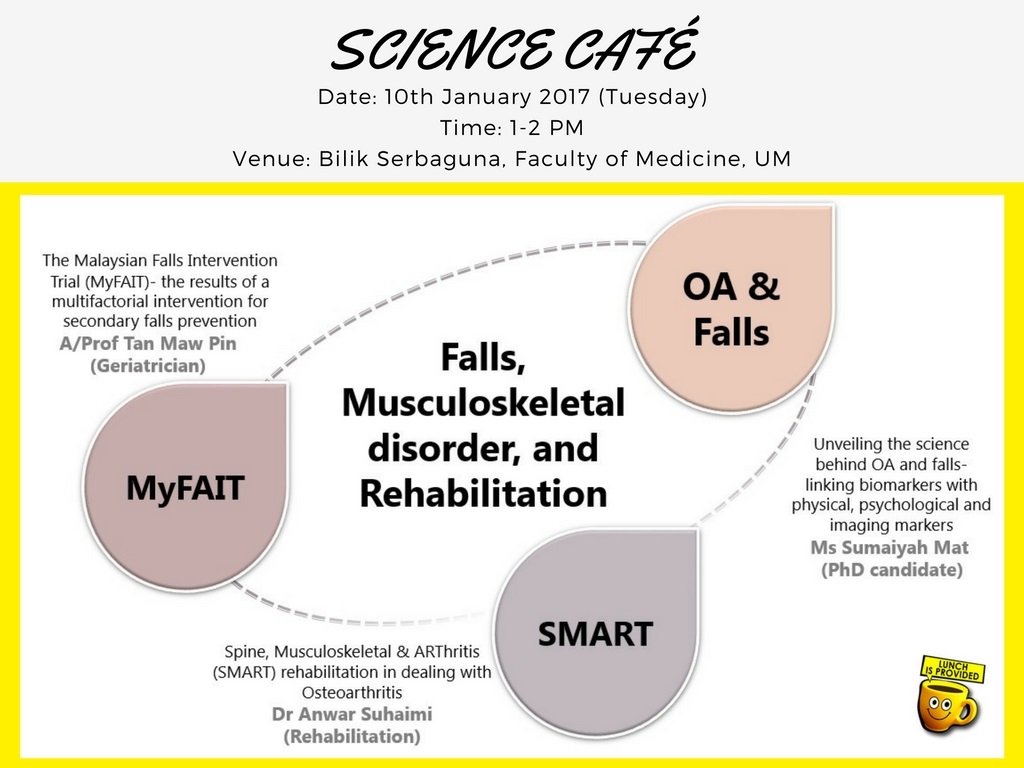Science Cafe January 2017: Falls, Musculoskeletal disorder, and Rehabilitation
Science Café Short Report, 10th January 2017
We finally left 2016 and entered the big 2017. Another year has passed, it only means that all of us have added another digit to our age. As time passes by, months after months leading up to another year, we progressively get older. It’s a cycle that human race cannot escape from. Therefore, it is crucial for us in understanding the issues facing aging seniors which brought us to Science Café topic of the month, “Falls, Musculoskeletal disorder, and Rehabilitation”.
The talk begun with Assoc. Prof. Tan Maw Pin, a geriatrician, presenting her results for The Malaysian Falls Assessment and Intervention Trial (MyFAIT). Her project was in line with a rapidly ageing global population, the rise in the frequency of falls will lead to increased healthcare and social care costs. So she did a few randomized controlled trials evaluating a multifaceted falls intervention in a low-middle income, culturally-diverse older Asian community. The primary objective was evaluate whether individually tailored multifactorial interventions will successfully reduce the number of falls among older adults. Malaysia is expected to have an ageing society by 2035, where the population size of people aged 60 years and over will reach 44.11 million. Falls as a cause of death in Malaysia is ranked 150 in the world. A fall has been as, “an unexpected event in which the participants come to rest on the ground, floor, or lower level”. From the result of her study, she discussed that given likely cultural, personal, lifestyle and health service differences in Asian countries, it is vital that individually-tailored multifaceted interventions are evaluated in an Asian population to determine applicability of these interventions in our setting. If successful, these approaches have the potential for widespread application in geriatric healthcare services, will reduce the projected escalation of falls and fall-related injuries, and improve the quality of life of our older community.
This inspiring talk was later continued by Sumaiyah Mat, a PhD Candidate, whom is a part of the Ageing and Age-associated Disorder Research group. She relates osteoarthritis (OA) and falls in elderly and unveil the science behind OA and falls by linking biomarkers with physical, psychological and imaging markers. OA is more that 80% prevalent in elderly. She focused more on candidate biomarkers such as inflammation which leads to pain, anti-catabolic relates to loss of balance, and psychologic state in terms of fear of falling, all are factors that could cause falling. She compared these data between fallers and non-fallers and concluded that these biomarkers are a potential tool in assessing risk of falls.
Lastly, Dr. Anwar Bin Suhaimi, took us on another turn as he explains his role with his spine, musculoskeletal & arthritis (SMART) rehabilitation in dealing with the patients themselves. He emphasized that more scientist and funders focuses more in communicable disease and neglecting topics related to elderly as the title is not “sexy enough” to grab people’s attention. Awareness should be made as eventually everyone will become old and face these difficulties.
Now, while everyone was indulging on our lunch menu, nasi goreng, all of us understood the urgency of the studies presented by the three respectable speakers. Which sums up and ends our Science Cafe topic for this month.
Download Here:
1) Science Café Short Report, 10th January 2017
2) The Malaysian Falls Assessment and Intervention Trial (MyFAIT)
3) Science Cafe Flyers: Falls, Musculoskeletal disorder, and Rehabilitation

